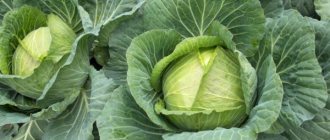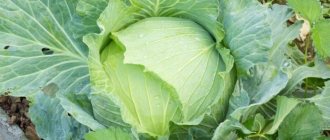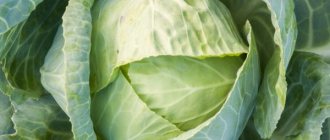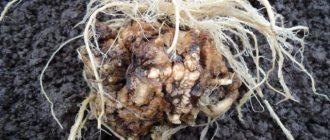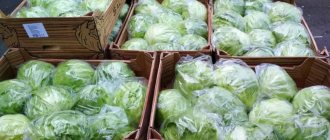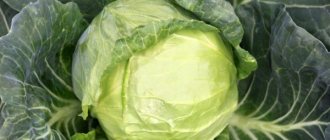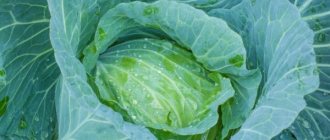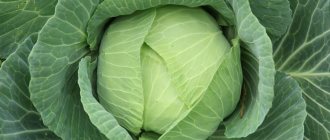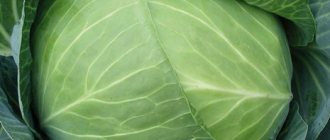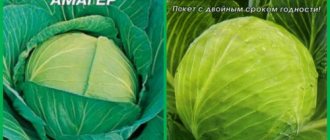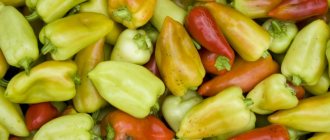Healing heads of cabbage for long-term storage - Snow White f1 white cabbage: full description
White cabbage Snow White belongs to the line of late varieties intended for long-term storage in winter. Advantages of the vegetable: excellent taste, pickling, marketability, high transportability.
| Landing location | Ripening time | View | Purpose | Origin | Maturation period | Weight |
| Open ground | Late ripening | White cabbage | Pickling, Cooking, Storage | Hybrid | 127-150 | 4–5 |
Description and characteristics of the variety
Snow White cabbage begins to ripen in the first weeks of September.
The variety was presented by the agricultural company Gardens of Russia; it is highly productive and well adapted to cultivation throughout the country.
- late ripening;
- diameter of heads of cabbage - 80–160 cm;
- average weight - 3–5 kg;
- leaf color is pale greenish;
- cut - snow-white, juicy;
- the outer stalk is round and small;
- density - average;
- edges are smooth;
- leaves - large;
- rosette - semi-spreading;
- There is a moderate waxy coating.
Cleaning lasts from November to the first of December (for the temperate zone).
Late white cabbage is perfectly stored without losing its crispness and juiciness for 4–5 months (huge heads of cabbage) and up to 7 months (medium-sized vegetables). Temperature range is within 0 degrees.
Where can it be stored in winter:
- in cellars and barns;
- under the awnings.
Growing and care
Agrotechnical cultivation rules:
- Water once every 2–4 days . The water norm is 6–8 liters per 1 sq. m. Maximum moisture is needed in August during the formation of heads of cabbage.
- Hilling is regular . Frequency: 1 time per week during intensive growth, then less often.
- Application of fertilizers . The first time is fertilized after 10–15 days, then after 2 weeks, and the last time when the heads are filled.
- saltpeter;
- superphosphate;
- potassium preparations;
- Agricola and Hera complexes.
Description of the head of cabbage
Heads of late-ripening varieties are the most productive and retain their beneficial properties for many months. According to the description, the leaves are large in size, their diameter is 80-160 cm. The color of the leaves is pale green, the edges are smooth.
Characteristics of the fruit surface:
- the surface is dense, with a waxy coating;
- external small stump of round shape.
The weight of heads of cabbage of the Snow White variety varies from 3 to 5 kg. When cut transversely, the flesh is white. The fruits are resistant to cracking.
Characteristics of the Snow White cabbage variety
Snow White cabbage is a late-ripening medicinal vegetable crop. When stored, it does not lose its presentation for a long time. The transportability of the variety is high.
Characteristics of the Snow White cabbage variety
Characteristics of the variety
Snow White cabbage actively ripens in early September. Seeds are usually planted as seedlings. Planting dates are March-April according to the 60 x 50 cm pattern. Seedlings are transplanted at the age of 35-40 days 1.5-2 cm deep.
The period from germination to technical maturity is 127-150 days. Marketable vegetable yield is 4.7-7.5 kg/sq. m.
Description of the head of cabbage
Heads of late-ripening varieties are the most productive and retain their beneficial properties for many months. According to the description, the leaves are large in size, their diameter is 80-160 cm. The color of the leaves is pale green, the edges are smooth.
Characteristics of the fruit surface:
- the surface is dense, with a waxy coating;
- external small stump of round shape.
The weight of heads of cabbage of the Snow White variety varies from 3 to 5 kg. When cut transversely, the flesh is white. The fruits are resistant to cracking.
Application and harvesting of vegetables
The variety is universal in use. Most often, the fruits are consumed fresh, for pickling or winter storage. Medium-sized vegetable crops can be stored fresh for up to 7 months at 0°C.
The late-ripening variety is harvested when the fruit becomes dense and heavy. Heads of cabbage that are too large spoil quickly. Medium-large ones are the optimal solution for preservation and use. Harvesting takes place from November to December 1st. A vegetable harvested prematurely quickly withers, and late-harvested heads of cabbage crack.
Vegetables collected in wet weather are dried. You can store fruits:
- on the street under a canopy;
- in the cellar;
- in the barn.
The humidity of the storage area should not exceed 90%, temperature - about 0°C. The fruits are cut together with roots or stalks no shorter than 3 cm. Different varieties cannot be kept together.
Growing
When growing cabbage, it is important to follow the rules
To get strong fruits, strong and healthy shoots are planted. To do this, adhere to the growing rules:
- The soil for sowing is prepared in the fall. To do this, mix 5 kg of turf soil, 5 kg of humus, 10 tbsp. l. ash.
- Before sowing, the treated seeds are heated. Them for 15 minutes. immersed in water at a temperature of 45°C. After this, the seeds are kept in cool water for 6 minutes. This increases cabbage resistance to fungal diseases.
- Seedlings are grown in early April.
- To ensure that the seedlings are strong, picking is carried out 7-14 days after emergence.
- The container is chosen 5 x 5 cm. Such dimensions allow you not to injure the young root when planting.
- The first feeding with the solution is carried out 8 days after picking. To do this, mix 2 g of potassium fertilizers and ammonium nitrate, 4 g of superphosphate and 1 liter of water. 1 liter of mixture is enough to fertilize 50-60 plants.
To avoid getting burned before feeding, the seedlings are watered. It is recommended to use a fluorescent lamp for seedling growth. It illuminates the seedlings for about 10-14 hours a day.
For soil, do not use soil from the garden on which cruciferous crops grew, in order to protect the cabbage from infections and bacteria. The best predecessors for Snow White cabbage are cucumbers, potatoes, and beans.
To obtain a good harvest and strong fruits, a number of agrotechnical measures are carried out
| Number | Agrotechnical event | Methods of application |
| 1 | Watering | After planting seedlings in open ground, watering is carried out every 2 days. To do this, take about 8 liters per 1 sq. m. Abundant watering is necessary in August. Before harvesting, water 2 times a week. |
| 2 | Loosening | It is carried out as the earth's crust appears until the formation of a head of cabbage. Hoes, flat cutters, and hand cultivators are used for loosening. |
| 3 | Fertilizers | The first fertilizing is applied 10-15 days after planting. The following mixture is suitable for this: 25 g of ammonia, 40 g of superphosphate, 10 g of potassium chloride and a bucket of water. After 2 weeks, a second feeding is carried out with a solution of ammonium nitrate. For the mixture, 40 g of the substance are dissolved in 10 liters of water. The third feeding is carried out at the moment of active growth of the head of cabbage. The following solution is used: 10 liters of water are mixed with 0.5 liters of mullein or chicken droppings and 15 g of potassium monophosphate. For 1 plant use 1 liter of mixture. In addition to fertilizers prepared at home, the plant is also fed with Agricola and Hera preparations. |
| 4 | Hilling | Hilling is carried out every week during the growth period, and after that every 14 days. The plant is sprinkled with wood ash. |
When caring, take into account the soil on which the vegetable grows. If the soil is highly acidic, there will not be a large harvest. To reduce acidity, the soil is fertilized with dolomite flour or wood ash. For 1 sq. m requires 500 g of flour or 1 kg of ash.
Watering cabbage is stopped 14 days before harvest, and the roots are exposed. This measure is also aimed at preventing the head of cabbage from cracking. You cannot plant cabbage in one place for 2-3 years.
Planting and care
Snow White cabbage is planted as seedlings in open ground. It is important to follow sowing dates and other rules in order to get a healthy crop and good yield.
Terms and conditions of landing
Sowing Snow White cabbage seeds for seedlings is carried out at the end of February or at the beginning of spring. Cultivation takes two months. Seedlings are moved to open ground at the beginning of summer.
Snow White cabbage prefers areas that meet the following requirements:
- elevated place;
- fertile loam;
- good lighting;
- early snow melting;
- no drafts.
Cabbage feels good after legumes, cucumbers, tomatoes, beets, onions, and carrots. To prevent diseases and pests, the crop can be returned to its original place no earlier than after four years.
You can grow Snow White cabbage seedlings in boxes or individual containers. It is permissible to use a ready-made soil mixture or make it yourself from equal parts of turf soil and humus. Add 1 tbsp per liter of composition. l. sifted wood ash. The soil for cabbage should be light and nutritious.
To prevent diseases and pests, the soil should be shed with a solution of potassium permanganate, calcined in the oven for 15 minutes, or disinfected in another way.
How to plant correctly
Snow White cabbage seeds are soaked in warm water before planting. All floating specimens are thrown away. The selected material is heated in hot water (50-55 °C) for 2-3 minutes. Instead, the seeds can be soaked in a solution of potassium permanganate for 15 minutes. After processing, rinse them with running water and dry. A growth stimulator like Epin is effective for soaking. Treat the seeds according to the instructions; there is no need to rinse them afterwards.
The sowing algorithm is as follows:
- Fill the containers with soil.
- Make grooves 2 cm deep at 5 cm intervals.
- Distribute the seeds at 1.5 cm intervals.
- Cover the crops with soil.
- Moisten the plantings.
- Make a film cover.
Keep the seedlings on a windowsill or other place with good lighting. Shoots will appear in a week, after which remove the cover.
Caring for seedlings includes moistening the soil with a spray bottle and maintaining the temperature from 15 °C
When a pair of true leaves appear, the seedlings are plucked. After 1.5 weeks, fertilizing is carried out. For 1 liter of water:
- potassium chloride 1 g;
- ammonium nitrate 2.5 g;
- superphosphate 4 g.
The next feeding is carried out after 1.5-2 weeks. Dissolve 3-4 g of ammonium nitrate in 1 liter of water, stir thoroughly, and water the seedlings. A week before planting in open ground, you can do one more feeding:
- water 1 l;
- potassium chloride 2 g;
- ammonium nitrate 3 g;
- superphosphate 8g.
The cabbage beds are prepared in advance. A few days before planting, you need to level the area and make holes. The seedlings are buried at 10x12 cm and planted according to the 50x60 cm pattern.
Aftercare
Caring for Snow White cabbage is easy. Main events:
- Water once every two days, 8 liters of water per 1 m². Increase consumption by 50% at the end of August.
- It is necessary to feed three times per season. You can use ready-made complex formulations such as Agricola, Hera.
- Systematically loosen the soil.
- Remove weeds regularly.
- Hill up the cabbage.
Comment! When caring for the crop, it is important not to damage the root system. Tools can be recessed to a maximum of 10 cm.
White cabbage 'Snow White'
Latin name: brassica oleracea var. capitata 'belosnegka'
Main genus: Cabbage
| The soil |
|
| Productivity |
|
| Ripening period |
|
| Soil type |
|
| Growing method |
|
| Purpose of fruits |
|
| Disease resistance |
|
| Soil ph requirements |
|
| Life form |
|
| Shape of fruits/stems/roots and tubers/heads |
|
| Size of fruits/stems/roots and tubers/heads |
|
| Cultivation region by origin |
|
| Vitamin content |
|
| Color of fruits/roots and tubers | |
| Leaf/stem/head color | |
| Fruit/root and tuber pulp color | |
| Peel thickness |
|
| Frost resistance |
|
| Drought resistance |
|
| Decorative value |
|
| Taste of fruits |
|
| Shelter for the winter |
|
| Pest resistance |
|
| Habit |
|
| Keeping quality |
|
| Parthenocarpic |
|
| Branching pattern |
|
| Density and character of the pulp |
|
Expand all properties
Description of the plant:
White cabbage 'Snow White' is a variety obtained by the Ukrainian Research Institute of Vegetable and Melon Growing.
Approved for use in the North Caucasus region in 1974.
Dimensions and growth form:
Representatives of the 'Snow White' variety have a semi-raised rosette of leaves, medium or large in size, with a diameter of 70–170 cm. The leaf is medium in size, whole or slightly lyre-shaped. The petiole is short or relatively long.
The color of the leaves is bluish-green, sometimes with a bluish tint. The edge is smooth or slightly wavy. The surface is slightly or moderately wrinkled with a strong waxy coating. Venation is average.
Kochan:
Size, shape and color:
The heads of cabbage are dense, weighing 3.5–4.6 kg. The covering leaves are smooth, with slight anthocyanin coloring. When cut, the head of cabbage is white.
Cabbage has good taste.
Ripening time and yield:
White cabbage 'Snow White' is a late ripening variety (late ripening). The period from mass germination to the onset of technical ripeness is 127–149 days. Marketable yield is 4.7–7.5 kg/m2.
Keeping quality:
The crop is characterized by good keeping quality when stored in winter.
Disease resistance:
The variety is relatively resistant to diseases.
Directions for use:
Recommended for fresh consumption and pickling.
Advantages and disadvantages of the variety
Judging by the description of the variety with photos and reviews, Snow White cabbage attracts gardeners mainly for its size, keeping quality and productivity. The benefits of the crop can be fully obtained if you follow all the rules of planting and care.
Before storing the cabbage in the cellar, be sure to dry it for two days, sort through it and remove damaged leaves.
Pros:
- good seed germination;
- large heads of cabbage;
- fruit resistance to cracking;
- juicy and crispy pulp;
- versatility of use;
- high productivity;
- long-term storage;
- frost resistance;
- good transportability.
Minuses:
- late maturation;
- average resistance to diseases and pests.
Comment! To maintain juiciness, freshness and prevent rotting, the temperature in the cellar should be 0-2 °C. aOptimal humidity is 80-90%.
Reviews about the product Snow White Cabbage
20 reviews for the product Snow White Cabbage
Write a review
befits
The similarity of the present, bought here, is good. I planted 3 varieties of grapes in the greenhouse, and they all turned out very well. At this time, the cabbage heads are large, but not juicy, because they are baked. I’m waiting until the end, maybe the situation will improve.
I recommend
I recommend a variety of cabbage that I am not indifferent to. My wife makes excellent sauerkraut from this variety and the family eats healthy salads all fall and winter. I would like to note the high quality of the seeds, and there are a lot of reviews about them, so the store is good.
I buy it all the time
cabbage is like cabbage, what to take from it. It is easy to grow from seeds, then it’s up to you to care for the vegetable. The seeds are excellent, I recommend them to everyone and I’ve been buying them myself for several years now.
like
I like the cabbage variety, the seedlings in the greenhouse turned out great, and they started growing well in the garden, but yesterday I saw some moths circling around the cabbage, I know I need to treat it so that aphids don’t attack.
cabbage garna
Cabbage is garnished with the fact that all of it came into my greenhouse in five days. I carefully dug and watered the soil, then planted it in rows and covered it with spittle.
seeds are ready
All the seeds are ready for planting, some have been sown and sprouted successfully. The tomato seeds sprouted well, and the pepper seeds were absolutely perfect. Moreover, I sowed thickly, so I will have to urgently thin out, because I don’t need so much.
I recommend
I recommend it to summer residents and I myself say so: Vikoryst is a great Ukrainian selection, even bred for our land. This gives hope for a larger harvest.
I recommend
The variety is excellent, the main thing is that it did not suffer from anything. The germination of the seeds also did not disappoint. I ordered this variety again and a couple more later ones, after all, my own cabbage is more reliable than buying it in the supermarket.
medium grade
This summer has not been very fruitful for me; out of 3 rows of planted seedlings, only 10-15 bushes have grown. Watering was of high quality.
The variety is productive, everything is still growing, but according to my estimates, there will be a lot of harvest. Not surprising, because the supplier’s seeds are of high quality.
It is a very late variety and I like it because its main growth occurs starting in September, when the heat subsides and there is already enough moisture.
I'm taking it for the first time
I bought the Snow White variety at my own risk. I’m more or less confident in the seeds, but I doubt the variety, but I’ll try it, as many people advise.
I planted seeds the old-fashioned way directly into holes in the garden. The seeds germinate very quickly and amicably. She carefully monitored their growth and protected them from the assistant. I transplanted it when the seedlings were large.
Diseases and pests
The relative resistance of Snow White cabbage to diseases and timely prevention allow you to avoid many problems. Use the following drugs effectively:
- Baktofit;
- Fundazol;
- Fitosporin;
- potassium permanganate – 4 g per bucket for spraying.
Among the pests, aphids can infect the crop. Control measures:
- drugs – Confidor, Prestige, Aktara, Tanrek, Biotlin;
- folk remedies - infusion of chamomile, potato tops, citrus peels, garlic, onions.
To prevent aphids, it is important to burn plant debris in the fall.
Another enemy of the crop is the cabbage whiteweed. Its caterpillars cause harm. Drugs used to combat:
- Bitoxibacillin;
- Alioth;
- Herald;
- Alatar.
The secretions of cabbage caterpillars provoke rotting of the above-ground parts of the plant.
Snow White cabbage also suffers from cruciferous bugs. Standard control measures include insecticides and folk remedies.
The spread of cruciferous bugs in spring is facilitated by last year's plant debris

